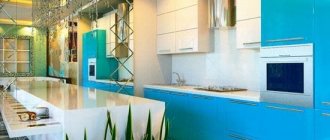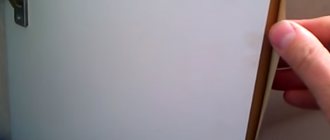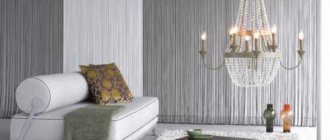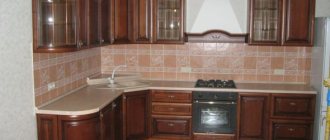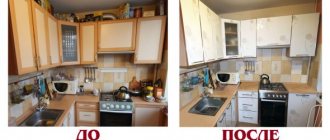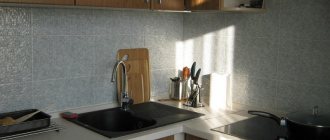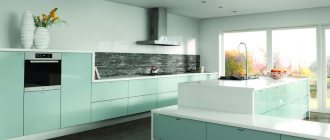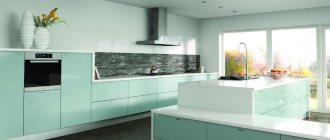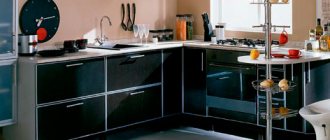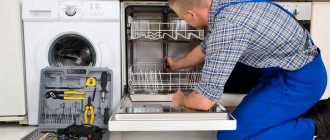A good quality kitchen set can last for decades. But time passes, and the shine of the new furniture fades, stains, chips and scratches appear, and your favorite set or any of its cabinets are no longer pleasing.
There are two ways out of this situation: do some repairs and buy new furniture, or update existing cabinets and pencil cases. Moreover, in the second case, the cost of the issue will be minimal, and you will not have to deal with rearrangements. All you need is decorative self-adhesive film.
Unlimited possibilities of self-adhesive film
Kitchens covered with film look impressive both in photos and in real life. Surfaces are updated using vinyl or other film. The range of this material is amazing in its diversity, and the price pleases with its affordable price.
Decorative “self-adhesive” imitates:
- natural wood of different species;
- natural stone;
- ceramics and tile texture;
- leather and fabric.
In the photo - imitation wood.
Its texture can resemble patterned silk, a colorful tapestry or cute chintz. The material is produced in matte and glossy versions. There are films with holographic and mirror patterns. And all this can be combined with each other, creating interesting effects, changing an ordinary kitchen cabinet beyond recognition, as in the photo below.
The price of the film depends on the manufacturer and the decorative surface.
Vinyl “self-adhesive” is quite practical because it:
- not afraid of moisture;
- does not fade in the sun;
- does not respond to temperature changes.
With its help, you can completely update the design of both the kitchen and the bathroom, transform the kitchen cabinet or the entire set.
Adhesive film is a good budget replacement for a full-fledged repair. Of course, you need certain knowledge and skills, but the video will help you quickly understand the intricacies of the process.
Color spectrum
When choosing a laminating film, you must take into account what color or texture it has. The choice of color depends on what kind of furniture needs to be covered, in what room it is located and what kind of furnishings need to be made in the room. When choosing colors, certain recommendations are taken into account:
- if it is necessary to cover items located in the children's room, then they must have bright and interesting colors or designs, as they must appeal to children;
- For a bedroom or living room, cut-to-length material with a brown or beige color is perfect;
- Glossy film for furniture is even available in textures that imitate natural wood or other expensive and specific materials, and these are most often used in the kitchen.
When choosing self-adhesive films and their colors, the painter who acts as the owner of the premises must additionally take into account his own preferences when creating a color scheme.
Which film should I choose?
First of all, you need to look at the thickness of the material and the manufacturer. German “self-adhesive” tapes are of good quality; their price depends on the thickness.
Dutch and Italian manufacturers have proven themselves to be excellent. You can choose something from budget series or take a closer look at exclusive products, but then the price will be quite high.
The most inexpensive are Chinese adhesive decorative materials from unknown manufacturers. However, low price should not be the main selection criterion, otherwise a beautiful kitchen decorated with self-adhesive vinyl film can quickly lose its appearance.
Not all adhesive materials intended for promotional products can be used in the interior. Some of them are designed for short-term use. Choose high-quality decor, and then the restoration will be durable, and a simple kitchen cabinet will become an interior decoration.
The color can be any. If you want to take a creative approach to kitchen design, place photos of fruits, vegetables or flowers on the facades, thereby decorating ordinary old furniture. The drawing can also be applied using photo printing.
Types of self-adhesive film
Regardless of the type, each self-adhesive has a good appearance and an optimal price. The main differences between types of films are the quality and individual aspects of their application.
In addition, there are differences in the quality of the adhesive base. Before gluing self-adhesive film to furniture with a flat surface, you should make sure that a thick layer of glue is applied to the area to be treated. For an uneven surface, on the contrary, less adhesive base is needed.
Self-adhesive polyvinyl chloride film used to decorate furniture facades must be of high quality and retain its appearance for as long as possible. The method of their production plays a big role in this.
There is a calendered type of self-adhesive film for furniture. Its main advantage is its low price, but this also leads to a disadvantage: the low price is due to insufficiently high-quality material that does not have a particularly long service life.
Calendered film is mainly used to decorate large rooms.
In addition to calendered and polyvinyl chloride films, there is cast self-adhesive film. It has a higher level of quality, and, accordingly, the highest cost.
Among its advantages are a high level of plasticity and a complete absence of shrinkage. Plasticity allows you to hide various fasteners underneath, and the absence of shrinkage guarantees a long service life of the coating.
Since calendered film is not durable enough, and cast film is quite expensive, the best option is polyvinyl chloride film. A huge selection of coatings can please everyone, including the most demanding customers. In addition, this type has many color options.
For example, you can purchase self-adhesive wenge film for furniture.
Technology of pasting furniture with polymer films
If you decide to update your kitchen furniture using self-adhesive film, then first prepare the base. It should be understood that the decorative covering will not hide potholes and bumps, it will only disguise the stains, so all unevenness must be removed before pasting. A video with tips will simplify the workflow.
12 rules for working with self-adhesive tape
- The fittings and doors must be removed, and each kitchen cabinet (facades and frame) must be inspected for the presence of depressions and bulges.
- If there are defects on the furniture, all irregularities are filled with putty and sanded well.
- To calculate material consumption, you will need measurements of all parts of the kitchen unit. You need to carefully measure all the parts that you plan to paste over.
- All dimensions are transferred to the back side of the film. It is usually made of white paper, on which the drawn lines are clearly visible.
- When cutting, you should always leave a margin of about 1 cm. This will help in your work: if you start gluing the vinyl at the wrong angle, the margin will make it possible to correct the situation. All excess is easily cut off with a breadboard knife.
- Decorative self-adhesive film is cut with a stationery knife, curved lines are cut out with scissors.
- Then you need to degrease all the surfaces to be decorated so that the “self-adhesive” does not come off over time. Window cleaning liquid or other products are suitable for this. Grease stains need to be treated especially carefully so that the decorative finish does not come off.
- Pasting of kitchen units is carried out on a dry and clean surface, otherwise the “self-adhesive” will begin to bubble and peel off from the base.
- The film must be applied evenly.
- The backing is removed in several stages: first, only a few centimeters are peeled off, after gluing them, a little more is removed, and so on until the entire panel covers the part to be decorated.
- Smooth out the plastic decor from the middle to the edges. Air bubbles must be removed during operation. It is convenient to work with a plastic scraper, stroking the surface with a soft cloth.
- Small air inclusions are removed with a needle. The finished part can be processed through the fabric with a warm iron.
Criterias of choice
This material is presented in numerous forms on the market, so choosing a self-adhesive design is often difficult, so some advice from professionals is taken into account:
- operating conditions - if the material covers interior items that are constantly located in residential heated premises, then it is allowed to buy the standard version. If it is necessary to cover elements located on the street, then a special lamination film is selected that is not afraid of negative temperatures;
- the condition of the surface that needs gluing. Pasting should be carried out exclusively on a base that is smooth and clean. If it is not possible to level the surface, then a film material consisting of several protective and dense layers is selected;
- attractive appearance. The purpose of lamination is to improve the appearance of various objects, so you must choose a material that has the desired color or texture. It should be suitable for the specific interior style and tastes of the owners of the premises;
- coloring - when decorating any furniture, you should decide what color the material will have. The most commonly chosen colors are black, red and white. If you just want to protect the surface, you can cover it using transparent material.
It is advisable to choose a product made of PVC rather than polyethylene. Acrylic film also has excellent parameters. It is sold by the cut, and photos of its varieties are presented below. By covering various furniture with acrylic, you can be sure of its protection from various negative influences. Furniture packaging films are used when transportation of structures is required, and at the same time it is necessary to protect them from possible contamination during this process.
Difficulties in work and their solutions
Problems often arise with processing the ends and shaped parts of kitchen units made of MDF or other material. An industrial or household hair dryer will be a good helper in this case.
The restoration will go faster if you work together: one person stretches the material by heating it with a hairdryer, the other carefully glues it to the base.
It is easier to apply the self-adhesive tape evenly on a damp surface. To do this, lightly moisten cabinets and doors with a spray bottle. Water will not allow the material to immediately grasp the surface and will provide an opportunity to correct the work.
When cutting the material, you need to make allowances on each side. For parts with ends, do not forget to make cuts in the corners. First, they paste over the part itself, and then proceed to the ends. The rounded ends of MDF facades are treated with a hairdryer for a better fit.
What to buy?
For rooms with low temperatures and high humidity levels, the best solution is injection molded self-adhesive. It is also suitable for very damaged facades. In other conditions, any type of self-adhesive film is suitable.
Despite the lower cost of polyethylene films, experts recommend using films made of polyvinyl chloride. Films with UV protection are also good. You should be careful with holographic films due to their high susceptibility to mechanical damage.
Here are photos of self-adhesive film for furniture.
Restoration of facades with decorative film
The appearance of the kitchen largely depends on the cladding of the facades. If your kitchen has smooth doors without a relief made of chipboard, then they can be easily covered with vinyl film.
Updating kitchen MDF facades with convexes will be easier if you use an industrial hair dryer. Only a well-heated film can take the desired shape. If there are decorative details on the facades, they must be removed before pasting.
Replacement of the old film is carried out only after removing the previous layer. Remember that decorative film is only applied to prepared surfaces.
It should be taken into account that in production, MDF film facades pass through a special press, which makes it possible to obtain a smooth surface without flaws. At home, MDF can only be covered with self-adhesive.
Nuances of use
How to glue this material so that the films adhere evenly? The procedure for working with it is considered quite simple, since only sequential actions are performed:
- the required amount of material purchased per cut is calculated;
- it is decided what parameters, appearance and other features it will have, and gloss or matte film can be chosen;
- material is purchased for cutting in the required quantity;
- the surfaces are prepared before directly gluing the new coating, and the plastic base only needs to be cleaned of dirt, but the wood is leveled and sanded;
- the film itself is prepared, for which it is cut into separate elements, with the help of which various objects will be pasted;
- the protective material is removed, after which the painter applies parts of the film with the sticky side to the desired areas of certain furniture;
- The film is aligned so that it adheres evenly and correctly;
- if a fairly large surface is being covered, then it is recommended to first apply a soap solution to the underside of the material, which will allow you to adjust its location for quite a long time;
- To level the painter, you can use a regular rag or roller, but you should not make significant efforts so as not to tear the coating, and a photo of the finished result is located below.
It is even possible to use special elements for the mirror, which are transparent and protective films, and they must be applied without using a soap solution. Thus, any home furnishings can be covered with self-adhesive furniture film. Provides effective protection of the covered element from various negative factors. Photos of different types of films are located below, and they are inexpensive, beautiful and durable. Working with them is considered so simple that it can easily be done on your own.
Interior renovation using film
Designers love polymer films. They have good plasticity and decorative properties; with their help you can quickly update almost any surface. Material suitable for decoration:
- tiles in the bathroom or kitchen;
- wall panels;
- doors;
- different furniture.
Films are available in different colors, with and without patterns. With their help, you can update your kitchen set and change old furniture in your home without extra costs. After all, the price of even the most expensive film will be cheaper than a new headset.
Restoring tiles using vinyl is not difficult. It is important to choose the right drawing here. Delicate chintz designs or films with textured embossing are suitable for the kitchen.
Complete the design with a decorative kitchen apron. Its restoration using film usually does not cause difficulties. The main thing is to carefully read the instructions on the roll.
Before gluing the tiles in the bathroom, you need to carefully prepare the surface - degrease it well. Otherwise, the film will quickly peel off.
Advantages and disadvantages
Self-adhesive vinyl film has numerous positive parameters:
- the resulting coating is not susceptible to exposure to moisture, which is especially important for kitchen furniture, which is why the material is most often used for it;
- does not fade with constant exposure to sunlight;
- the procedure for gluing different surfaces is a simple and understandable job that every residential property owner can do with his own hands;
- temperature changes do not have any effect on the coating;
- provides an attractive and radical update to the appearance of the room, and you don’t have to spend a lot of money on it;
- the cost of the material is considered affordable for any buyer;
- vinyl films for furniture are universal, so they can be used in the kitchen or other areas of residential property;
- It is easy to clean the coating, and for this you can use various cleaning products that do not contain abrasives.
The disadvantages of this solution for updating furniture include the fact that it is quite easy to damage the integrity of the coating using simple mechanical influences. This is especially true in the kitchen, where numerous sharp cooking tools are used. The above positive parameters are inherent only in high-quality material, so when choosing a film it is recommended to purchase a not too cheap option.
